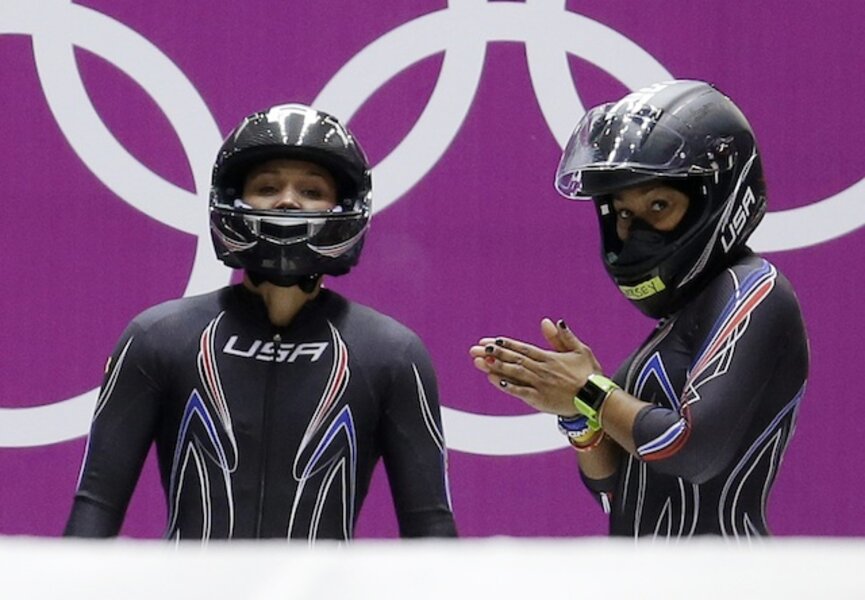Can Lolo Jones medal? That depends on the pilot in front of her
Loading...
| Sochi, Russia
For Lolo Jones, the Summer Olympic hurdler turned bobsled brakeman, the Olympics will last about 20 seconds. That's how long it will take for her to run down the top of the bobsled track, head bobbing, legs churning, in her four heats combined before she hops in and lets Jazmine Fenlator do the rest.
But what, exactly, goes on under the hood as a bobsled rumbles down the track is one of the great mysteries of the sport. Ask USA 1 pilot Elana Meyers what she does to keep her sled fast and right-side up, and body language seems to be more effective than English. Her fiancé says she sways in the car when she drives through road curves.
And that just about explains it. For the best bobsled pilots in the world, driving is not something they do, it is something they feel.
A bobsled, after all, is not a Cadillac Escalade with GPS, blind zone alert, and heated leather seats. It's a big carbon fiber bullet with two rings inside. Pull the right one to go right. Pull the left one to go left.
But to leave it at that would be to end up at the bottom of the track in a quaking ball of fear, because, to hear pilots talk, it seems that the bobsled drives them as much as they drive it. On a sheet of ice at 90 miles per hour, you can't exactly turn on the blinker and make a right-hand turn to avoid the wall coming at you out of the darkness. A ride down the track is a conversation, they say, and those who listen to what the sled is saying are those who win the medals.
Meyers is off to a strong start. She and her teammate Lauryn Williams, another Summer Olympian turned bobsledder, are in first place after Day 1 of the two-day event. Jones and Fenlator are in 11th, with a third USA sled in third.
It helps that when Meyers first got in the pilot's seat years ago, she already knew what a correct turn felt like. She had been the brakeman for Olympic medal-winning pilots Shauna Rohbock and Erin Pac, and she knew the sensation. The trick was getting the sled to do it when she was in the front seat.
That process is not always one that makes much sense. "When you're new, you think, 'I'm going into a curve, and it's left, so I'm going to turn left,' " said Steve Holcomb, who won bronze in the two-man Monday, at an October media summit.
Except, that's not always what to do.
"This is near frictionless surface," Holcomb noted, and the usual rules don't apply.
At first, all the sensations are strange. Since the sled is actually made up of two parts, the nose of the sled will begin twisting into the turn before the back end where the pilot and brakeman sit. Then there's the fact that everything is shaking like the Millennium Falcon preparing for the jump to hyperspace.
A dance with the sled
The key is in recognizing that every one of those shudders is saying something about where the sled is and where it wants to be.
"There's an ideal line, but you're never on it," Holcomb said. "Maybe once every 500 times."
Getting it there can be a dance with the sled, persuading it with every limb.
When you get in, "your knees are touching the nose, the seat is wrapped around your hips, and your shoulders are up against the sled," said Holcomb, visually drawing the sled in the air around him in an attempt to convey the feeling. "You feel every little thing."
And of course, as he said this, he began to sway.
Indeed, shifting your weight within the sled, both for pilots and brakemen, is one way to cajole it toward that perfect line. "There is a right place to be, and over time you figure out what that feels like and how to get there," Holcomb said.
For Meyers, that means making the sled a part of her.
"When I'm not on point it feels like two different people" – the sled and her, she said in October. When she finds that place where she and sled are working together, though, "if I move side to side, I feel the sled move side to side."
Getting that rhythm right is particularly important on this Olympic track. After Georgian luger Nodar Kumaritashvili was killed on the Whistler track in the Vancouver 2010 Olympics, designers here have made a much slower track that includes sections that actually go uphill.
"I've never been on anything like it," says Holcomb. "It's not easy to get down to the bottom fast."
That means pilots need to maintain the sled's speed by driving clean.
By coaxing his sled into third Monday, Holcomb ending a 62-year US medal drought in the two-man event.
Meyers has had her problems, crashing in a training run, but seems to have righted herself. As for Jones, she and Fenlator in the USA 3 sled are the longest of long shots in 11th. But Jones, a hurdler who is competing in Sochi after failing to medal in two Summer Games, embraces her long-shot role.
"It's Jaz's first Olympics. She's all about just having a good experience and just executing. That's the two goals for her," she told the Associated Press. "And for me it's just all about being the best teammate and giving her the best, most amazing push and velocity that she could ever ask or hope for."








